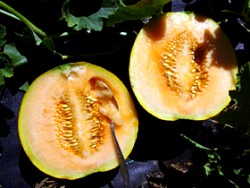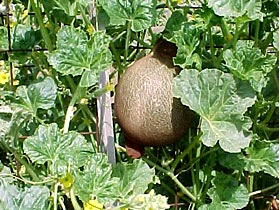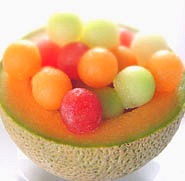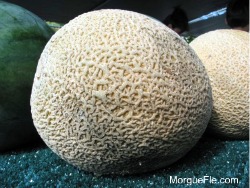Edible of the Month: Cantaloupe

There's nothing sweeter and juicier than a vine ripened cantaloupe picked fresh from your garden on a warm summer's day.

Melon vines love to run, so in small spaces plant bush-type varieties or set plants on the edge of the garden where the vines can run onto the lawn.
If you've got the room, you've got to grow cantaloupes. These melons are technically called muskmelons, but we all know them for their round
green fruits with brown netting and sweet salmon or orange colored
flesh. A cantaloupe freshly picked from the garden is warm, sweet, and
juicy. It's great served chilled for breakfast or chopped and mixed
with other fruits for a light dessert at dinner. I like to put some
cantaloupe in my fruit shakes in the morning for a sweet taste, along
with bananas and other summer fruits. You can even make a cool melon
soup from fresh cantaloupes to compliment a late summer meal.
Although cantaloupes do sprawl and take up room, each vine can reward you with 3 to 4 melons each. In our 6 foot diameter melon patch,
my wife Wendy and I were able to harvest almost 20 melons one year. We
had to start doing the unthinkable and giving them away, we had so many.
So find a spot in your garden or lawn next year to start some melons. Here's a primer to get you off on the right foot.
Planning
Cantaloupes like room, heat, and water. While you can locate them in the garden, since they vine and take up so much space, I like to create
a separate cantaloupe patch in the lawn or plant them along the edge of
the garden and train them to vine into the lawn. That way prime real
estate in the garden isn't used up by melon vines and leaves. Also,
locate your patch near a water source. Melons are water hogs and need
moisture to produce fruits up to 10 pounds, depending on the variety.
Of course, find a spot in full sun, protected from cool winds, and on
fertile ground.
Cantaloupes are sometimes grouped as Eastern or Western types. Eastern cantaloupe varieties feature rounded 5- to 7-pound fruits with
sutures, netting, and a large seed cavity. Western cantaloupe types are
oval-shaped 3- to 5-pound fruits without sutures and have coarse
netting. It's mostly a distinction for commercial growers. You can grow
either type anywhere in the country.
Here are some of the best cantaloupe varieties to try in your garden. They all mature in 75 to 85 days after planting from seed.
'Alaska Hybrid' – This early maturing, 4 pound, orange-fleshed fruit is good for northern areas with short growing seasons.
'Ambrosia Hybrid' – This 5-pound cantaloupe has sweet salmon-colored flesh and the vines are resistant to powdery mildew disease.
'Athena Hybrid' – These 5- to 6-pound, salmon-colored fruits are crack resistant and grow on disease resistant plants.
'Hales Best' – This is an heirloom cantaloupe that's early maturing with 4-pound, orange-fleshed fruits.
'Halona Hybrid' – These disease-resistant plants produce 5-to 6-pound, sweetly flavorful fruits with bright orange flesh. They mature even earlier than 'Earliqueen'.
'Honey Bun Hybrid' – This new variety features 4 pound, orange-fleshed fruits that grow on short vines that only run 3 to 4 feet. They're perfect for a small garden.
'Jenny Lind' – A New Jersey heirloom, unique green-fleshed cantaloupe that produces 2-pound fruits with soft, juicy flesh. The fruits have a characteristic button on the bottom.
'Superstar Hybrid' – A large, 6- to 8-pound melon with aromatic orange flesh.
'Tasty Bites Hybrid' – A small, 1- to 2-pound melon with yellowish-orange flesh. This variety is a great size for individual servings.
Preparation
Cantaloupes need heat, fertility, and water to grow their best. Find a location in full sun. Prepare raised beds a few weeks before your
last frost date and amend the beds with a 1- to 2-inch thick layer of
compost. In cool summer areas consider laying black or dark green
plastic mulch over the raised bed to preheat the soil before planting.
Cantaloupe seed germinates best in warm soils.
Planting

Melons make a healthy dessert when mixed with other fruits or eaten on their own.

Harvest melons when the netting turns brown and the fruit "slips" off the vine when lifted.
Either start cantaloupe seedlings indoors 3- to 4-weeks before your planting date or sow seed after your last frost date directly into the
garden. Plant cantaloupes in hills or rows. Space hills 4- to 6-feet
apart and sow 6 seeds per hill. After germination, thin to the three
strongest seedlings. To plant in rows, poke holes in the plastic and
plant seedlings or seeds 12 inches apart.
Young cantaloupes need consistent warmth to grow their best. Protect young seedlings in spring by covering them with a floating row cover during cool, windy days or if temperatures dip into the 40Fs at night.
Care
Keep the cantaloupe patch well weeded and watered. Once the plants begin vining, the cantaloupe leaves will become so thick they will shade the soil, keeping it moist and preventing weeds from growing.
Apply at least 1-inch of water a week — more during periods of hot, dry weather. Adequate watering is particularly important during flowering and fruiting.
Cantaloupes are in the cucumber family and have this family’s characteristic separate male and female flowers. Pollination from bees
is necessary to get fruits. Remove the floating row cover when
flowering begins to allow bees access to the flowers. If you have a
stretch of cloudy, cool weather when bees aren't flying or live in an
area with few native bees, pollinate the fruits yourself. In the
morning, take a cotton swab and collect the pollen from a male flower
(the one with no small cantaloupe behind it). Then find a female flower
(the one with a small cantaloupe behind it) and swish the swab in that
flower. That should do the trick.
Fertilize your cantaloupe vines with a balanced organic fertilizer, such as 5-5-5, when the vines begin to run and at first fruiting. In a
small garden, manually train the vines to run into a lawn or away from
other plants. You can also trellis them up a fence by tying the vines
to the fence with plant ties and supporting the developing fruits with
panty hose or cloth.
Pests love cantaloupes, too. Control cucumber beetles early in the season with row covers, yellow sticky traps hung above plants, and
sprays of pyrethrum in the evening when bees aren’t flying. Crush
squash bugs eggs in early summer and also spray pyrethrum as a last
resort to control this pest. Fence the cantaloupe patch to keep
raccoons away. Cover individual fruits with hardware cloth or a wire
cage if mice are active. Both animals love ripe melons and will let you
know when it's time to pick by their activity. Plant disease resistant
varieties if powdery mildew and wilt are problems in your garden. In a
small garden you can also place individual fruits on cans or pots to
keep them off the ground. They will be less likely to be attacked by
pests and diseases. Rotate crops annually and clean up plant debris
well in fall.
Harvest
Cantaloupes are one of the easier melons to know when to harvest. Look at the ribbing. It will change to a darker brown color when fruits
are ripe. Cantaloupes will also give off a sweet scent when ripe. Sniff
fruits regularly when they are full size. The best method is to lift
the fruits off the ground. A ripe cantaloupe will "slip" of come off
the vine easily when ripe. Cantaloupes can be stored for about 1 week
in the refrigerator, but I think they're best eaten as quickly as
possible after harvest.
Views: 8
© 2025 Created by Aggie.
Powered by
![]()